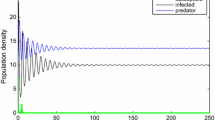Abstract
We present a model for transmissible diseases spreading among predators in a predator–prey system. Upon successful contact, a susceptible individual becomes infected but is not yet able to spread the disease further. After an incubation period, the diseased individual becomes infectious. We investigate the system’s equilibria by analytical and numerical means. For a suitable set of parameter values, the system shows persistent oscillations. The model also exhibits bistability of the coexistence equilibrium with the prey-only equilibrium.







Similar content being viewed by others
References
Malchow, H., Petrovskii, S., Venturino, E.: Spatiotemporal Patterns in Ecology and Epidemiology. CRC, Boca Raton, Florida (2008)
Gao, L.Q., Hethcote, H.W.: Disease transmission models with density-dependent demographics. J. Math. Biol. 30, 717–731 (1992)
Mena-Lorca, J., Hethcote, H.W.: Dynamic models of infectious diseases as regulator of population sizes. J. Math. Biol. 30, 693–716 (1992)
Beltrami, E., Carroll, T.O.: Modelling the role of viral disease in recurrent phytoplankton blooms. J. Math. Biol. 32, 857–863 (1994)
Hadeler, K.P., Freedman, H.I.: Predator–prey populations with parasitic infection. J. Math. Biol. 27, 609–631 (1989)
Venturino, E., The influence of diseases on Lotka–Volterra systems. IMA Preprint Series #913, IMA, Minneapolis, USA (1992)
Venturino, E.: The influence of diseases on Lotka–Volterra systems. Rocky Mt. J. Math. 24, 381–402 (1994)
Venturino, E.: Epidemics in predator–prey models: disease among the prey. In: Arino, O., Axelrod, D., Kimmel, M., Langlais, M. (eds.) Mathematical Population Dynamics: Analysis of Heterogeneity, vol. 1: Theory of Epidemics, pp. 381–393. Wuertz Publishing Ltd, Winnipeg, Canada (1995)
Chattopadhyay, J., Arino, O.: A predator–prey model with disease in the prey. Nonlinear Anal. 36, 747–766 (1999)
Arino, O., El Abdllaoui, A., Mikram, J., Chattopadhyay, J.: Infection on prey population may act as a biological control in ratio-dependent predator–prey model. Nonlinearity 17, 1101–1116 (2004)
Delgado, M., Molina-Becerra, M., Suarez, A.: Relating disease and predation: equilibria of an epidemic model. Math. Methods Appl. Sci. 28, 349–362 (2005)
Han, L., Ma, Z., Hethcote, H.W.: Four predator–prey models with infectious diseases. Math. Comput. Model. 30, 849–858 (2001)
Haque, M., Venturino, E.: The role of transmissible diseases in Holling–Tanner predator–prey model. Theor. Popul. Biol. 70, 273–288 (2006)
Venturino, E.: Epidemics in predator–prey models: disease in the predators. IMA J. Math. Appl. Med. Biol. 19, 185–205 (2002)
Venturino, E.: Ecoepidemic models with disease incubation and selective hunting. J. Comput. Appl. Math. 234, 2883–2901 (2010)
Hethcote, H.W.: The mathematics of infectious diseases. SIAM Rev. 42, 599–653 (2000)
Pugliese, A.: An S→E→I epidemic model with varying population size. In: Busenberg, S., Martelli, M. (eds.) Differential Equations Models in Biology, Epidemiology and Ecology, pp. 121–138. Springer, Berlin (1991)
Gao, L.Q., Mena-Lorca, J., Hethcote, H.W.: Four SEI endemic models with periodicity and separatrices. Math. Biosci. 128, 157–184 (1995)
Gao, L.Q., Mena-Lorca, J., Hethcote, H.W.: Variations on a theme of SEI endemic models. In: Martelli, M., Cooke, C.L., Cumberbatch, E., Tang, B., Thieme, H.R. (eds.) Differential Equations and Applications to Biology and Industry, pp. 191–207. World Scientific, Singapore (1996)
Oliveira, N., Hilker, F.: Modelling disease introduction as biological control of invasive predators to preserve endangered prey. Bull. Math. Biol. 72, 444–468 (2010)
Hilker, F., Schmitz, K.: Disease-induced stabilization of predator–prey oscillations. J. Theor. Biol. 255, 299–306 (2008)
Hilker, F., Langlais, M., Malchow, H.: The Allee effect and infectious diseases: extinction, multistability, and the (dis-)appearance of oscillations. Am. Nat. 173, 72–88 (2009)
Acknowledgements
The authors thank the referees for their suggestions that contributed to improve the paper. The authors are also indebted to Frank Hilker for a very useful discussion on this matter and for providing Fig. 7.
Author information
Authors and Affiliations
Corresponding author
Additional information
All the authors contributed equally to this paper.
Rights and permissions
About this article
Cite this article
Tannoia, C., Torre, E. & Venturino, E. An incubating diseased-predator ecoepidemic model. J Biol Phys 38, 705–720 (2012). https://doi.org/10.1007/s10867-012-9281-9
Received:
Accepted:
Published:
Issue Date:
DOI: https://doi.org/10.1007/s10867-012-9281-9




